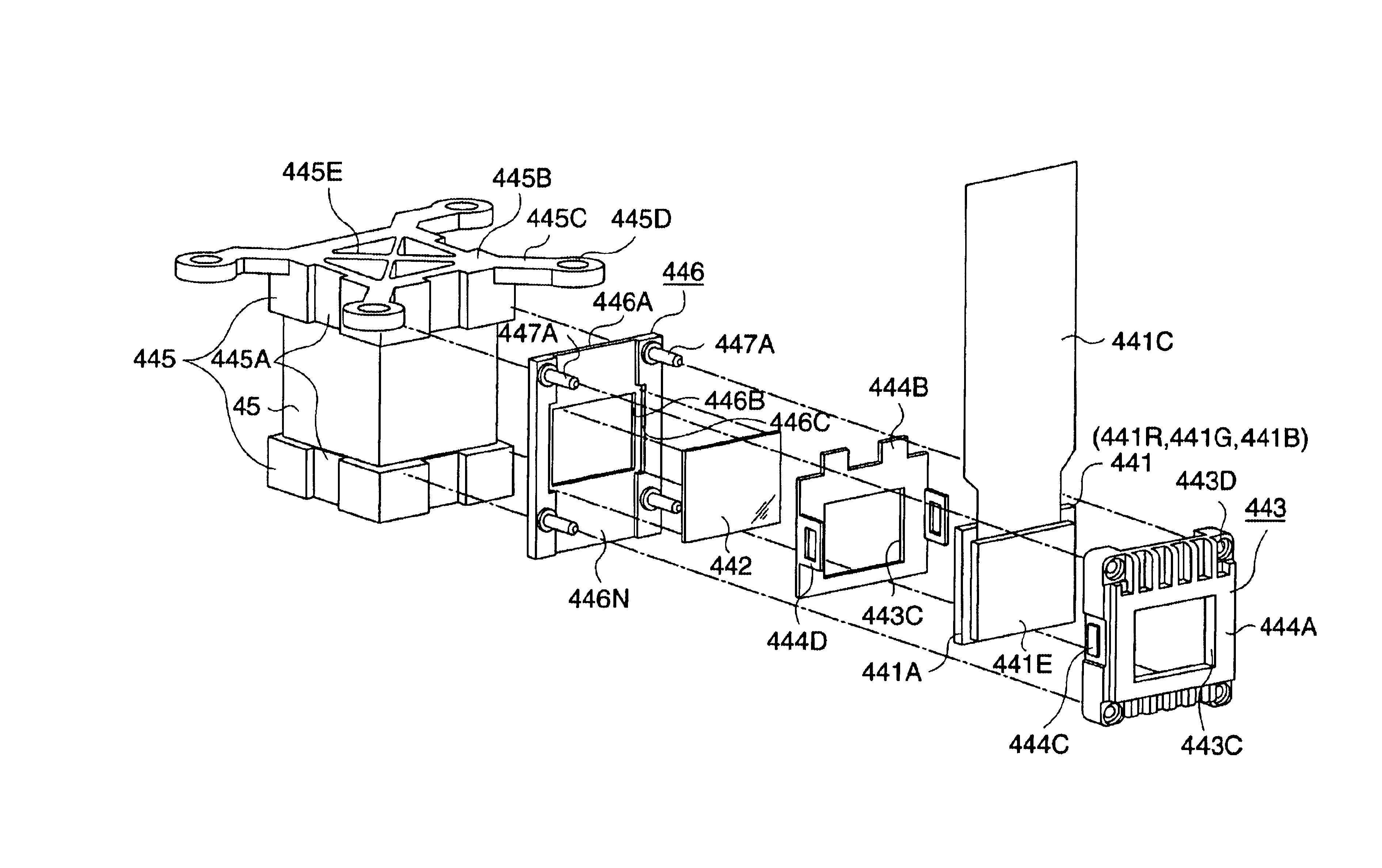Optical device, method for manufacturing optical device, and projector
a technology for optical devices and manufacturing methods, applied in the direction of projection devices, television systems, instruments, etc., can solve the problems of large number of parts, relatively difficult manufacturing, complicated structure, etc., and achieve the effect of shortening the manufacturing steps, reducing the size of the optical device, and simplifying the structur
- Summary
- Abstract
- Description
- Claims
- Application Information
AI Technical Summary
Benefits of technology
Problems solved by technology
Method used
Image
Examples
first embodiment
[0154]FIG. 1 is an overall perspective view of an exemplary projector 1 as viewed from above. FIG. 2 is an overall perspective view of the projector 1 as viewed from below. FIG. 3 through FIG. 5 are perspective views of the interior of the projector 1. Specifically, FIG. 3 is a diagram wherein an upper case 21 of the projector 1 has been removed from the state shown in FIG. 1, FIG. 4 is a diagram with a shield plate 80, a driver board 90, and an upper housing 472 removed from the state shown in FIG. 3 as viewed from the rear side, and FIG. 5 is a diagram wherein an optical unit 4 has been removed from the state shown in FIG. 4. The parts 4, 21, 80, 90, and 472, which make up the projector, will be described below in detail.
[0155]In FIG. 1 through FIG. 5, the projector 1 has an external case 2, an electric power source unit 3 stored in the external case 2, and an optical unit 4 disposed in the external case 2 as well, having a U-shaped flat form, with an overall generally rectangula...
third embodiment
[0255]The third embodiment according to the present invention will be described next.
[0256]In the following description, parts and structures the same as with the first embodiment are denoted with the same reference numerals, and detailed description thereof will be omitted or simplified.
[0257]With the optical device according to the first embodiment, the holding member 446 has pins 447A provided in a protruding condition from the four corners of the rectangular plate-shaped member 446A. Conversely, the optical device according to the third embodiment differs in the point that the holding member 446 has erected pieces 447C with a general L-shape when viewed from the front, as shown in FIG. 16. Other configurations and manufacturing methods are the same as with the first embodiment.
[0258]Specifically, the erected pieces 447C are positioned at the four corners of the rectangular plate-shaped member 446A so as to extend following the edge of the rectangular plate-shaped member 446A, an...
fourth embodiment
[0262]The fourth embodiment according to the present invention will be described next.
[0263]In the following description, parts and structures the same as the first embodiment are denoted with the same reference numerals, and detailed description thereof will be omitted or simplified.
[0264]With the first embodiment, bases 445 are fixed to both the top and bottom faces of the cross-dichroic prism 45 (both of a pair of end faces intersecting the light flux incident end face), with the holding member 446 being fixed by adhesion to the side faces of the bases 445. Further, a polarizing plate 442 is fixed to engaging grooves 446C of the holding member 446 by double-face tape or an adhesive agent.
[0265]Conversely, the fourth embodiment differs in the point that the holding member 446 is fixed by adhesion to the light flux incident end face of the cross-dichroic prism 45, and also, the base 445 is provided on only one of the pair of end faces intersecting with the light flux incident end f...
PUM
 Login to View More
Login to View More Abstract
Description
Claims
Application Information
 Login to View More
Login to View More - R&D
- Intellectual Property
- Life Sciences
- Materials
- Tech Scout
- Unparalleled Data Quality
- Higher Quality Content
- 60% Fewer Hallucinations
Browse by: Latest US Patents, China's latest patents, Technical Efficacy Thesaurus, Application Domain, Technology Topic, Popular Technical Reports.
© 2025 PatSnap. All rights reserved.Legal|Privacy policy|Modern Slavery Act Transparency Statement|Sitemap|About US| Contact US: help@patsnap.com



